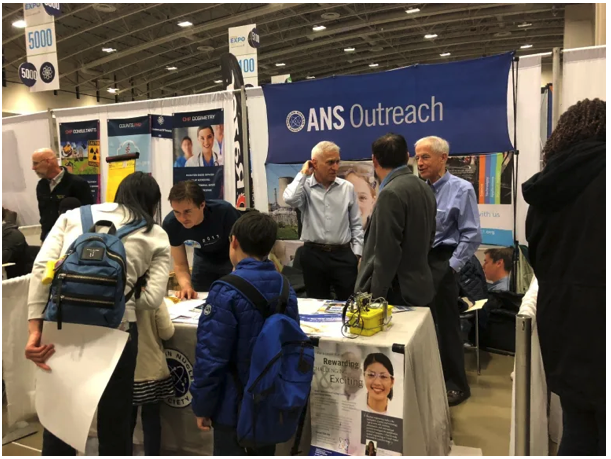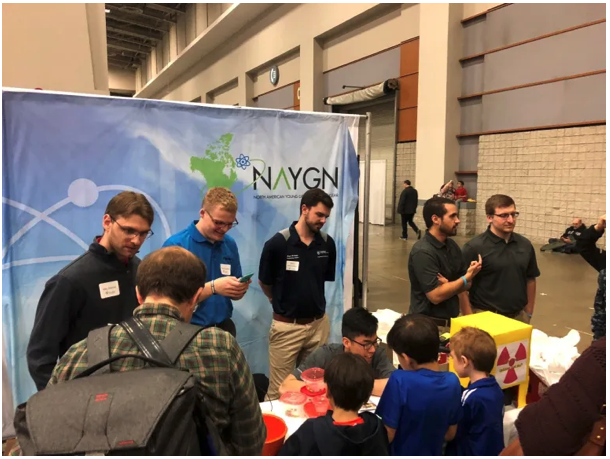USA Science & Engineering Festival Comes to Washington, D.C.: Energy and Sustainability Among the Topics in Focus
On April 7 and 8, 2018, the USA Science & Engineering Festival took over the Walter E. Washington Convention Center in Washington, D.C. The Science & Engineering Festival has been held annually in the nation’s capital since 2010, with the stated goal of “inspiring the next generation of scientists & engineers at the most exciting, educational and entertaining science festival in the United States.” And while the festival is aimed mainly at getting young boys and girls involved in potential futures in STEM (science, technology, engineering, and math) careers, there are also exhibits, shows, and demonstrations that aim to tickle the curiosity and amazement of children and adults alike.
After hearing that the Science & Engineering Festival being held just blocks from where I live, I was instantly inspired to attend this (free!) event for my own enjoyment of the pageantry of science, but I was also eager to see what energy-related topics were being championed to these budding scientists and engineers of tomorrow– future colleagues, even! While all STEM fields are important and deserve attention, I was curious to see what sort of focus might be given to energy, climate change, and the like. So with my phone to take photos along with a pen and notepad in tow, I was off to the Convention Center.
Overall impression
Not knowing what to expect from my first trip to the USA Science & Engineering Festival, I quickly learned that this event was equal part career day at school, science fair, and college/job fair, but what made it even better was that almost every booth was interactive and had informed people staffing them who were eager to engage and share their work and their passion. Throughout the convention floor you could find booth after booth with demonstrations, as well as the Einstein Stage that had a constant stream of speakers and presentations.
Even better, especially for families looking to pique their children’s interests in STEM, was the fact that the Science & Engineering Festival is completely free. While anyone who wanted to support this amazing type of education event was presented with opportunities to donate to the Festival and ensure it remains free moving forward, it was notable to see the push to keep such an educational event completely open to the public ( a great type of initiative that can help to push for environmental and energy justice). On top of that, the various speakers and activity booths also did a fantastic job focusing particularly on getting young girls interested in STEM fields that have long been disproportionately male.
Energy and sustainability booths
The USA Science & Engineering Festival had all of its activities separated into a variety of pavilions that grouped organizations and companies in similar fields, including aviation, earth sciences, natural sciences, space exploration, and more. The pavilions I focused on for the sake of this blog, though, were the energy pavilion and the sustainability pavilion. What follows is my (admittedly-amateur) photographic tour of the booths in those pavilions that were most directly tied to energy and could serve to inspire the future generation of energy engineers, creators of new renewable technologies, or climate science advocates.
Chevron
Chevron had the largest footprint in the energy and sustainability pavilions, and the oil company used that floorspace to create their Chevron STEMZone.
Chevron is a multinational energy corporation, ranking as one of the world’s largest oil companies. While I would have expected them to focus largely on the science of energy, the activities in the Chevron STEMZone took the opportunity to educate on not just energy or oil, but rather they had a variety of activities meant to inspire future scientists in all sorts of fields. A few of their exhibits included a giant Newton’s cradle to teach about momentum and physics, as well as a chemical engineering section where kids could create their own lip balm or slime. The direct creation of energy was not an included topic, but rather their goal was to inspire scientists of any future type, seeing as Chevron has research and development in all sorts of laboratories across the world.
American Petroleum Institute
The American Petroleum Institute (API) was also present representing the oil industry and the Science & Engineering Festival, using virtual reality technology and even Lego sets to educate children on what sort of work goes into oil platforms and what jobs people have to do on these rigs.
Department of Energy
The U.S. Department of Energy (DOE) was in the house to educate children and their parents on what types of job opportunities the government agency has for the rising rock stars in the STEM fields. The representatives from DOE, seen below posing with the mascot of Headfirst Camps, were there to emphasize just how wide the world of energy stretches and how instrumental the Department’s work in those fields is.
American Nuclear Society
The American Nuclear Society works with everything nuclear, and they were on hand to provide outreach for their organization. For the children that went to this booth, they were rewarded with a live Geiger counter and information on what nuclear radiation is and its place in the world.
Idaho National Laboratory
The Idaho National Laboratory, a national laboratory in the DOE lab system, was also present and had several of the most classic hands-on tools used to get kids interested in science– a Van de Graaf generator, (another) Geiger counter, and some secret messages that could be solved with their decoder tools.
North American Young Generation in Nuclear
The North American Young Generation in Nuclear is another organization that focuses on spreading information and awareness of nuclear science and technology, especially in the energy fields. Their presence certainly added to the overall nuclear footprint at the Festival, and they also brought a type of Geiger counter to teach kids about how nuclear radiation is measured and why.
National High Magnetic Field Laboratory
The National High Magnetic Field Laboratory was in the energy pavilion and benefited from having some of the most naturally interactive and hands-on materials with which to work– super strong magnets! In doing so, this lab was able to educate children and adults alike of the importance of magnets (particularly extremely powerful ones) in the field of energy production.
The Optical Society of America
The Optical Society of America exists to spread knowledge about all sorts of optics, both for the sake of pure science and for use in practical applications. This booth was one of my favorites as it spoke to my past involvement in the DOE’s setting of energy efficiency standards for lighting products, where the interactive exhibit demonstrated the efficacy of various light types, showed how much money can be saved by converting your home’s lighting to more efficient bulbs, walked you through how to look at the color spectrum outputs of bulbs, and showed how the more efficient compact fluorescent lamps and LED bulbs are easily able to replicate any light you may be replacing.
American Welding Society
One of the weekend’s surprise hottest booths was from the American Welding Society. In their large trailer exhibit, they took children through a virtual reality experience in what it is like to weld. While this booth is only tangentially related to the energy world (any large-scale energy production facility is surely going to need skilled welders on staff), I include it because the line for this exhibit was always long and I have to give proper kudos for the organization for taking a topic that might have sounded mundane on paper and making it truly exciting for those kids in attendance.
Environmental Protection Agency
The U.S. Environmental Protection Agency (EPA) was present in the sustainability pavilion, featuring roughly two dozen college sustainability teams from across the country who had been chosen to present their entries to the EPA Sustainability Competition. These projects were serious scientific endeavors completed by advanced collegiate teams, so they were more certainly geared towards the parents than their children, but seeing them share their hard work with those in attendance was greatly rewarding in its own right.
American Society for Civil Engineers
The American Society for Civil Engineers was also in the sustainability pavilion with an examination of asphalt and how materials science is progressing to allow us to create more sustainable and earth-friendly asphalt. This type of project is especially welcome considering asphalt is one of the largest contributors to climate change of which many do not seem aware.
Center for Biotechnology Education at Johns Hopkins University
The sustainability pavilion was not just about energy, but also included some fascinating exhibits on biological aspects of the environment. While again not directly tied to energy, I did want to give props to the Center for Biotechnology Education at Johns Hopkins University for their imaginative demonstration that allowed children to receive an owl pellet (their polite way of saying owl feces) to dissect and identify parts of the owl diet that their bodies are unable to digest, such as bones from rodents or parts of smaller birds.
Final notes
The USA Science & Engineering Festival was a greatly entertaining and education afternoon, for children, families, and adults. The work this Festival is doing to inspire the next generation of scientists and engineers is commendable and important, and for that the organizers should be applauded.
However, attending this Festival as someone dedicated to energy-related issues, I must say I did come away a bit disappointed that there weren’t more booths and organizations that were directly about energy generation, energy efficiency, or climate change (especially when two of the pavilions were billed as energy and sustainability). If I’m looking to inspire the next generation of energy engineers specifically, I would have loved to see some booth demonstrating how solar panels or wind turbines work, what steam generators do, the technology behind electric vehicles, the importance of a diverse and evolving energy mix, why clean energy is important, and more. I’d even love to see some of the basics in energy education, like having a bicycle connected to a light bulb to demonstrate just how much power goes into various types of lights, giving kids a tangible understanding of how much energy is wasted when the lights are left on.
I realize it sounds like I’m being a curmudgeon and complaining about a Festival aimed at children where all those in attendance seemed to be having a blast and learning a lot, but that is not my intent. This iteration of the USA Science & Engineering Festival was clearly a resounding success and did much to inspire kids in the STEM fields, so I’m just speaking as a fanatic in the energy industry who wants some of these budding scientists and engineers to get interested in the future of energy as well. Who knows what potential inventors of the next generation of energy market disruptors were in attendance?
In the end, though, everywhere you looked there were not only children excited about science in attendance with their parents, but there were also young boys and girls volunteering at the event all over. The USA Science & Engineering Festival was overflowing with enthusiasm, making clear just how bright the future of science will be.

















